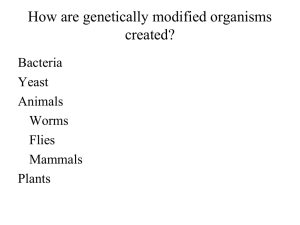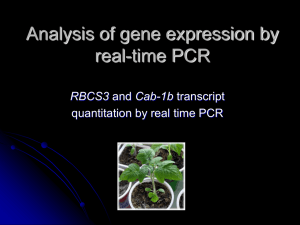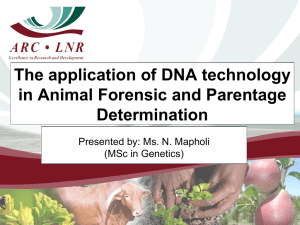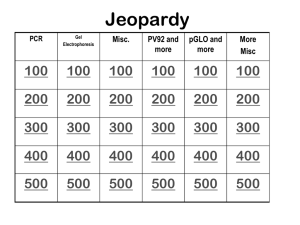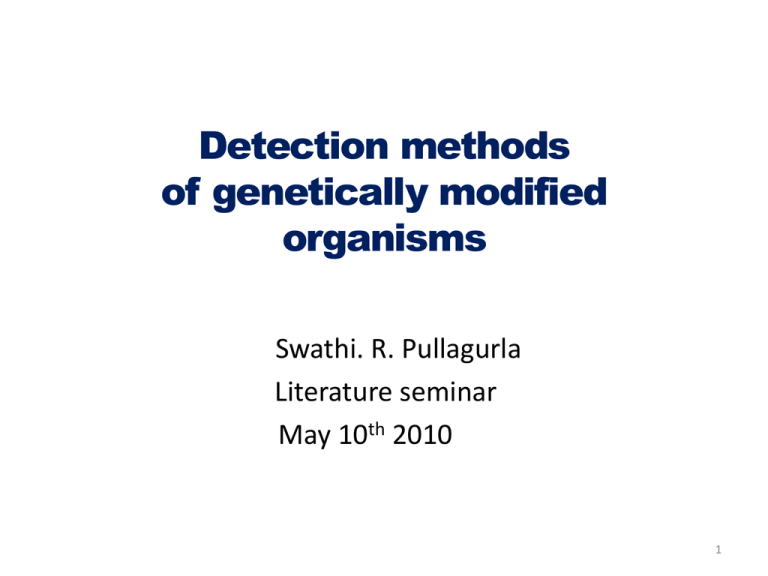
Detection methods
of genetically modified
organisms
Swathi. R. Pullagurla
Literature seminar
May 10th 2010
1
Overview
•
•
•
•
•
•
•
•
Goal
Genetically modified organisms(GMOs)
Detection methods of GMOs
CE and Electrochemiluminescence
Fluorescence Cross-correlation Spectroscopy
Results
Critiques
Acknowledgements
2
Goal
.
To detect the target DNA in genetically
modified organisms using PCR and PCR free
techniques
3
Genetically modified
organisms
Organisms with
modified genome
Exogenous gene
Confers new
characteristics
http://www.glofish.com, http://othersideoftheplanet.com
E. Mariotti, M. Minunni and M. Mascini, Anal. Chim. Acta 453 (2002), pp.165-172
4
GMO’s
81.3 million
hectares of world’s
area
60% of foods in US
supermarkets
contain GMOs
.
European Union
regulations stipulate
the labeling of GM
products with more
than 0.9%
Beachy, R.N.(1999) Facing fear of biotechnology. Science 285,335
Deisingh et al. Food Research International, Vol 38, Issue 6, July 2005, Pages 639-649
5
Significance of GMO’S
Increased global food production
Increased resistance to pests and
diseases
Adaptability to harsh growing
conditions
Desirable functional and nutritional
characteristics
Tolerance to safe herbicides
http://biotech.cas.psu.edu
6
Roundup Ready Soy (RRS)
Glyphosate-resistant crop
developed by Monsanto (EPA 2002)
Common elements in GMO constructs:
35 S promoter from Cauliflower
mosaic virus (p35S)
Terminator from the nopaline
synthetase gene of Agrobacterium
tumefaciens (tNOS)
Farid. E. Ahmed, Trends in Biotechnology Vol.20 No.5 may 2002
7
GMO testing of food
Food sample
DNA Extraction
Positive
PCR test
approved
for GMO’s
Positive
(GMO
labeling)
GMO
screening 35S
promoter
PCR test
Negative
No GMO labeling
Negative
(No authorized
food)
Deisingh et.al, Food Research International 38 (2005) 639–649
8
Detection methods
Protein based testing methods
Western Blot
ELISA
Lateral flow strip
DNA based testing methods
Southern blot
PCR
Quantitative real time PCR
Biosensors & Microarrays
Farid. E. Ahmed Trends in Biotechnology 20 (2002) 215-223
9
Why DNA based methods?
Genetic code is universal and
DNA is ubiquitous molecule
Nucleic acids are thermo-stable
whereas proteins are thermosensitive
Low amounts of DNA can be
amplified using PCR techniques
Food proteins are not detectable
upon processing
E. Gachet et al./Trends in Food Science & Technology 9 (1999) 380±388
http://www.chemistry.nmsu.edu/~research/MARC/images/dna_strand.jpg
Versatile
Sensitive
Specific
Precise
10
Capillary Electrophoresis with
Electrochemiluminiscent Detection for
Highly Sensitive Assay of Genetically
Modified Organisms
Longhua Guo, Huanghao Yang, Bin Qui, Xueyang Xiao, Linlin Xue,
Donghwan Kim and Guonan Chen
Anal. Chem. 2009, 81, 9578-9584
11
Objective
To investigate the conditions for DNA
amplification, CE-ECL separation and
detection
12
Electrochemiluminescence
Reactive species are generated
from stable precursors at the
surface of an electrode
Ru(bpy)32+ was the first inorganic
complex to show ECL
Annihilation mechanism is the
general one for ECL generation
http://chemistry.illinois.edu/research/materials/seminar_abstracts
13
CE-ECL detection interface
1.Electrophoretic buffer reservoir
2.Coreactant Injection entrance
3.ECL detection window
4. Pt grounding electrode
5. Waste exit
6. Silver wire quasi-reference
electrode
7. Working electrode
8. Pt Counter electrode
9. Separation capillary
10. Detection capillary
11. Etched capillary porous joint
14
Approach for GMO detection
Primer labeling
CE-ECL
approach
• Heat resistive ECL
luminophore (Ru(phen)32+)
• Multi-target detection
15
Polymerase Chain Reaction (PCR)
•
Consists of ~ 25-45 cycles
•
Each cycle consists of 3 steps
Denaturation of DNA (template)
at 91-97oC
Annealing of primers to the
template
• 5oC below the lowest Tm
of primers
Extension of primers and
attachment of dNTPs at
optimum 72oC (100 bases/s)
•
•
•
•
C = N (En ) 2n
C = Copy number of target after PCR
N = Starting copy number
En = Amplification efficiency of cycle
n = Cycle number
http://users.ugent.be/~avierstr/principles/pcrsteps.gif
Phases in PCR
Traditional PCR
detection
Area of
detection for
Real-time
http://www.savethefrogs.com/chytrid/images/ABI-realtime-vs-conventional-PCR.pdf
17
Real-Time PCR
Measurement of gene expression levels
Low DNA copy number detection
Bacteria and virus detection
Real-Time PCR chemistry
SYBR® Green (Molecular Probes)
A fluorogenic dye that exhibits little
fluorescence when in solution, but
emits a strong fluorescent signal upon
binding to double-stranded DNA
18
Experimental procedure
Fabrication of CE-ECL System
Genomic DNA extraction
Activation of Ru(phen)32+
Primer labeling & purification
Real time- PCR
Capillary electrophoresis
19
Primer labeling
• 4 mg of EDC & 11 mg of sulpho-NHS added to 1 mL of
Ru(phen)32+ DMF solution (10 mM).
Activation of • Incubated in the dark for 120 min at room temperature & 10 µl
of 2-mercaptoethanol was added.
Ru(phen)32+
Labeling
Purification
• Dissolved in phosphate buffer saline & 25 times of Ru(phen)32+NHS stock added to primer solution.
• Stirred for 30 min at room temperature in the dark.
• Purified by TIAN quick oligo kit.
• Stored at -20° C before PCR amplification.
20
Primers used in PCR
Primer
Target
Sequence
Amplicon length
(bp)
U-35S
D-35S
35S
CCGACAGTGGTCCCAAAGATG
AGAGGAAGGGTCTTGCGAAGG
158
U-NOS
D-NOS
NOS
GAATCCTGTTGCCGGTCTTG
GCGGGACTCTAATCATAAAAACC
125
U-epsps
D-epsps
cp4-epsps
GCAAATCCTCTGGCCTTTCC
CTTGCCCGTATTGATGACGTC
145
U-lectin
D-lectin
lectin
GGGTGAGGATAGGGTTCTCTG
GCGATCGAGTAGTGAGAGTCG
210
21
Optimized PCR conditions
Primer concentration Template DNA
concentration
U&D-lectin – 0.1 µM
U&D- 35S– 0.3 µM
U&D-NOS – 0.35 µM
U&D - epsps- 0.5 µM
100 ng
(per 25 µL)
Mg2+
conc.
dNTP
concentration
Anneal
temp.
1.5 mM
0.5 mM
59° C
22
Optimized CE conditions
Sieving matrix
Buffer
pH
Separation
voltage
Injection time
PVP – 2.5 %
Tris HCl- 20
mmol/L
8
300 V/cm
12 s
23
Results
24
RT-PCR detection of RRS
35S labeled with Ru(phen)32+
25
Stability of primers
labeled with Ru(phen)3
+2
Time after
labeling (day)
0
Migration time
(s)
834 ± 10
8367 ± 103
1
829 ± 9
8218 ± 136
2
833 ± 11
8257 ± 122
3
835 ± 8
8244 ± 146
4
822 ± 12
8167 ± 149
5
828 ± 11
8259 ± 131
6
837 ± 10
8217 ± 124
7
831 ± 13
8266 ± 157
U-lectin was tested
ECL count
26
Certified reference material
(CRM) standards of RRS
Lectin
NOS cp4-epsps
35S
27
Reproducibility
Objective
gene
Size (bp)
Average
(count)
RSD%
Average
(s)
RSD %
NOS
125
4653
3.77
988
2.36
cp4-epsps
145
3879
4.23
1125
2.79
35S
158
6732
4.67
1240
1.87
lectin
210
5087
3.87
1312
1.91
28
Simulative soybean sample
with RRS content of 0.01 %
29
Conclusions
Labeling based CE-ECL is a sensitive method
for PCR amplicon detection.
Amplification efficiency was not decreased
after ECL labeling.
The limit of detection is found to be 0.01%
with 35 PCR cycles.
30
PCR-Free Detection of Genetically
Modified Organisms Using
Magnetic Capture Technology and
Fluorescence Cross-Correlation
Spectroscopy
Xiaoming Zhou, Da Xing, Yonghong Tan, Wei R. Chen
Plos One. Nov. 2009, Vol.4, Issue 11
31
Objective
To detect and quantify the target DNA
using dual-color fluorescence crosscorrelation spectroscopy
32
Fluorescence Correlation
Spectroscopy (FCS)
Powerful method for determining
molecular interactions in vitro and in
vivo
Time-averaging fluctuation analysis of
small molecular ensembles
Fluctuations in the fluorescence
signal are induced by molecules
entering and leaving the illuminated
region by random diffusive motion
Schwille et.al, BioEssays 24:758–764
33
What is FCCS?
Extended version of FCS
First proposed by Eigen and Rigler in 1994
Two spectrally different fluorophores
Two excitation sources
Two detectors
34
Fluorescence correlation
Spectrometer
35
Schwille et al., Biophysics Textbook Online 2001, 1–33
Simultaneous Detection of a DoublyLabeled Target at the single-molecule level
Rhodamine Green
Detection Channel
(527 nm)
Cy5 Detection Channel
(666 nm)
Time (s)
Slide from Dr.Wonbae Lee
Coincident Events
Cross-correlation Function, Gc (τ)
I1 (t )I 2 (t )
Gc ( )
I1 I 2
Intensity
t=0
τ = 10-2s
τ = 10-4s
time (sec)
τ = 10-3s
Slide from Dr. Wonbae Lee
Experimental procedure
Genomic DNA was extracted using cetyltrimethyl
ammonium bromide (CTAB) method.
EcoR V and Hinf I are used to cleave 211 bp
target from CaMV35S promoter.
Streptavidin coated magnetic beads were used to
purify target DNA through biotin-streptavidin
linkage.
Purified target DNA was hybridized with two dye
labeled gene probes.
38
PCR-free identification of GMO’s
by magnetic capture FCCS
35S promoter DNA
Biotin labeled
capture probe
Streptavidin
coated magnetic
bead
Magnetic field
RG labeled gene
Cy5 labeled
gene
39
Results
40
Cross-correlation functions of
singly labeled gene probes
41
Sensitivity and reliability
assessment
42
FCCS detection in soybean
GM-soybean with magnetic capture
technology
GM-soybean without
magnetic capture technology
Non-GM soybean
control
43
Comparison between various
methods of GMO detection
Parameter
ELISA
Southern
blot
PCR
Real time Current
PCR
assay
Sensitivity
Moderate
Moderate
High
High
Moderate
Specificity
Fair
Good
Fair
Fair
Excellent
Assay time
6-8 h
2-4 d
1.5 d
1d
8-10 h
Potential to
be
quantitative
Yes
No
No
Yes
Yes
Needs
special
equipment
Yes
Yes
Yes
Yes
Yes
44
Conclusions
A magnetic bead based PCR-free method was
introduced.
Sensitivity & accuracy of the FCCS system was
evaluated by PCR.
Sensitivity of 0.05 nM was observed.
45
Acknowledgements
Dr. Soper
Dr. Robin L. Mc Carley
Soper research group
46



